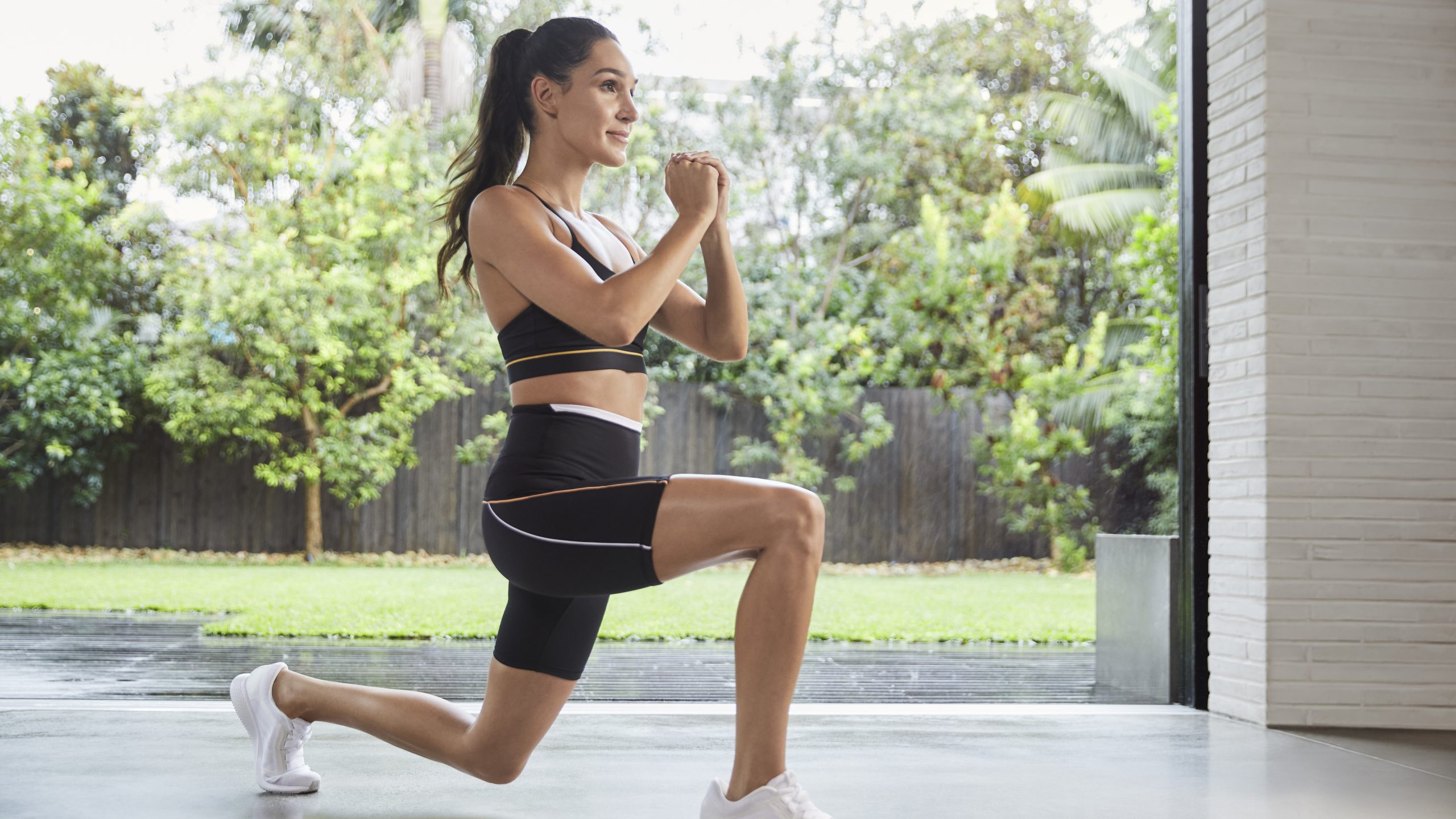This is the best full body workout, according to a world-renowned trainer
Kayla Itsines shares her go-to sweat session.


So, you're after a full body workout? Combining the best bodyweight exercises, the below bodyweight workout from one of the world's top PT's promises to get your heart rate up in no time.
While there are loads of different types of full body workouts, head trainer and founder of SWEAT Kayla Itsines is a fan of high intensity interval training.
The workout was invented in 2005 by Kirsten Burgomaster and made even more famous by national treasure Joe Wicks during lockdown last year. It involves short, sharp bursts of (yep, you guessed it) high intensity intervals to help you get your heart rate up fast.
Making time for your fitness routine and maintaining consistency are key to achieving your health and fitness goals - which is why HIIT workouts are ideal sweat sessions for if you're short on time and keen to boost your cardiovascular fitness.
Your need-to-knows: this full body workout has been designed to challenge your strength and endurance with a combination of high intensity exercises that work your core, shoulders, glutes, quads and hamstrings. It can be done anywhere, requires no equipment and is short enough to fit around your schedule.
Ready? Set? Sweat. Don't miss our guides to the best bodyweight upper body exercises and best bodyweight leg workout, while you're here.
Try this 14 minute full body workout if you're short on time
Duration: 14 minutes
Do: All seven moves for 30 seconds - bar the glute bridge, which you should hold for 60 seconds - and then repeat two times, doing three rounds in total.
Rest: For 30 seconds at the end of each round.
Type of workout: Full body high intensity interval training circuit.
Warm up
Try this: 3 to 5 minutes of jogging in place or skipping - to help to increase your heart rate and warm up your muscles - and a couple of minutes of dynamic stretches, such as leg swings and torso twists, which can help to increase your range of motion as well as help to reduce the risk of injury.
1. Sumo Squat Pulse
a. Plant both feet on the floor further than hip-width apart. Point both feet slightly outward. This is your starting position.
b. Inhale. Looking straight ahead, bend at both the hips and knees, ensuring that your knees remain in line with your toes. Continue bending your knees until your upper legs are parallel with the floor. Ensure that your back remains within a 45- to 90-degree angle to your hips. This is called full squat position.
c. Exhale. Push through your heels and extend your legs slightly.
d. Bend your knees again to return to full squat position. Continue this pulse action for the specified number of repetitions.
2. Commando
a. Start by placing your forearms (wrist to elbow) on a yoga mat and extending both of your legs behind you, resting on the balls of your feet. This is your starting position.
b. Inhale. Exhale. Release your right forearm to place your hand firmly on the mat directly below your right shoulder and push up onto your right hand. Release your left forearm to place your hand firmly on the mat directly below your left shoulder and push up onto your left hand. Ensure that you keep your core activated to prevent your hips from swaying.
c. Inhale. Release your right hand and lower your forearm to the mat, then release your left hand and lower your forearm to the mat to return to the starting position. Repeat this exercise, starting with your left arm. Continue alternating between right and left for the specified number of repetitions.
3. X Plank
a. Place both hands on the floor shoulder-width apart and both feet apart behind you, resting on the balls of your feet. Brace your abdominals and maintain a neutral spine, ensuring that your hands are directly below your shoulders. This is your starting position.
b. Inhale. While stabilising through your abdominals, elevate your hips and release your left hand to reach towards your right foot (or as far as you can).
c. Exhale. Lower your hips and place your left hand on the mat to return to the starting position.
d. Inhale. While stabilising through your abdominals, elevate your hips and release your right hand to reach towards your left foot (or as far as you can).
e. Exhale. Lower your hips and place your right hand on the mat to return to the starting position. Continue alternating between left and right for the specified amount of repetitions. Each repetition is equivalent to one touch of your hand to your foot.
4. Single Leg Glute Bridge
a. Lie flat on your back on a yoga mat. Bend your left knee and position your foot firmly on the mat, extending your right leg directly in front of you or to the ceiling, ensuring your spine is in a neutral position. Allow your arms to rest by your sides on the mat. This is your starting position.
b. Inhale. Exhale. Gently draw your ribs to your hips to engage your core. Press your left heel into the mat, activate your glutes and raise your pelvis off the floor until your body forms one straight line from chin to knee, resting on your shoulders.
c. Inhale. Lower your pelvis to return to the starting position. Complete half of the specified repetitions on the same side before completing the remaining repetitions on the other side.
5. Reverse Table Top
a. Begin seated on a yoga mat, legs straight and resting your hands slightly wider than your shoulders. This is your starting position.
b. Press your heels into the floor, using your hamstrings and glutes to lift your hips and extend through your shoulders so that your body forms a straight line from your chest down to your knees. Ensure that your shoulders are directly over your wrists and your knees are directly over your ankles.
c. Slowly lower your hips down to return to the starting position. Repeat for the specified number of repetitions.
6. Reverse Lunge
a. Plant both feet on the floor shoulder-width apart. Gently draw your pubic bone to your belly button (engage pelvic floor). This is your starting position.
b. Inhale. Carefully take a big step backwards with your right foot. As you plant your right foot on the floor, bend both knees to approximately 90-degrees, ensuring that your weight is evenly distributed between both legs. When done correctly, your front knee will be aligned with your ankle and your back knee will be hovering just off the floor.
c. Exhale. Extend both knees and transfer your weight completely onto your left foot. Step your right foot forward to return to the starting position.
d. Inhale. Carefully take a big step backwards with your left foot. As you plant your left foot on the floor, bend both knees to approximately 90-degrees, ensuring that your weight is evenly distributed between both legs. When done correctly, your front knee will be aligned with your ankle and your back knee will be hovering just off the floor.
e. Exhale. Extend both knees and transfer your weight completely onto your right foot. Step your left foot forward to return to the starting position. Continue alternating between right and left for the specified number of repetitions.
7. Broad Jump & High Knees
a. Begin by planting both feet on the floor shoulder-width apart. Gently draw your pubic bone to your belly button (engage pelvic floor). This is your starting position.
b. Inhale. Swing your arms backward and, at the same time, bend at both the hips and knees, ensuring that your knees remain in line with your toes. Continue bending your knees until your upper legs are parallel with the floor. Ensure that your back remains between a 45- to 90-degree angle to your hips.
c. Exhale. Swing your arms to propel your body upwards and forwards, once again, landing in squat position. Ensure that you maintain ‘soft’ knees as you land to prevent injury.
d. Inhale. As you extend your legs, transfer your weight on to your left foot, and bend your right leg to bring your knee into your chest. Lower your right leg and plant your foot on the floor. Keeping your weight on your right leg, bend your left leg to bring your knee into your chest. Once you are comfortable with this movement, increase your speed so that you are hopping from one foot to the other.
e. Continue alternating between left and right legs, at the same time moving backwards, until you return to your starting position. You should feel tension through your quads, glutes, and core throughout this movement. Continue alternating between broad jump and high knees for the specified amount of repetitions or time.
Cool down
Try this: After your full body workout, do 3 to 5 minutes of walking to help to slowly lower your heart rate to normal levels and help your body to cool down after a workout.
Static stretching is also good as part of your cool down - aka holding a single position for twenty seconds or longer.
Celebrity news, beauty, fashion advice, and fascinating features, delivered straight to your inbox!

Ally is Marie Claire UK's Senior Health and Sustainability Editor, a well-regarded wellness expert, ten-time marathoner, and Boston Qualifying runner.
Utilising her impressive skillset and exceptional quality of writing, she pens investigative, review and first-person pieces that consistently demonstrate flair and originality.
As well as writing, Ally manages a team of freelancers, oversees all commissioning and strategy for her pillars, and spearheads the brand's annual Women in Sport covers, interviewing and shooting the likes of Mary Earps, Millie Bright, and Ilona Maher. Shortlisted for three BSMEs and winning one in 2022, Ally lives and breathes her verticals: her eye for a story and connections within the wellness sphere are unrivalled. Follow Ally on Instagram for more.